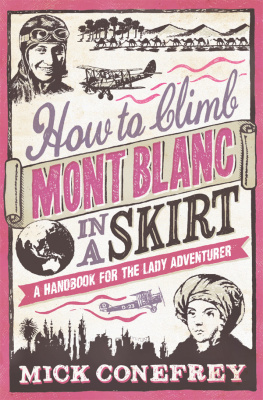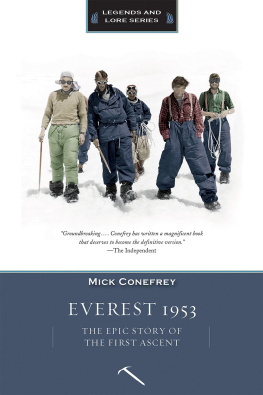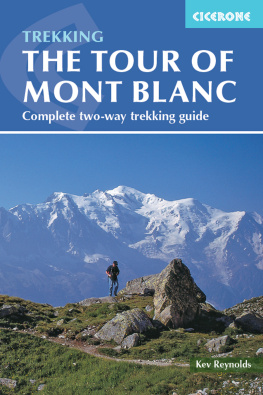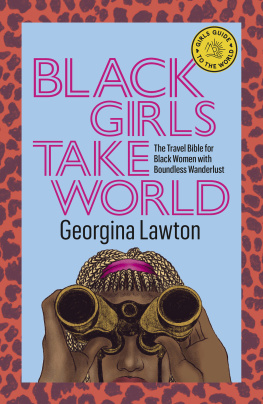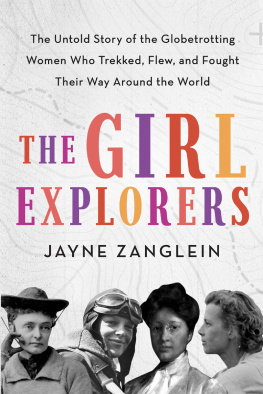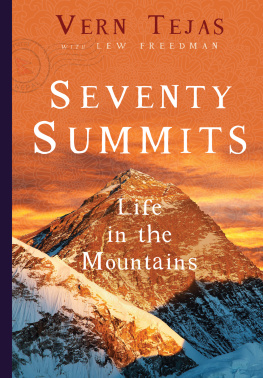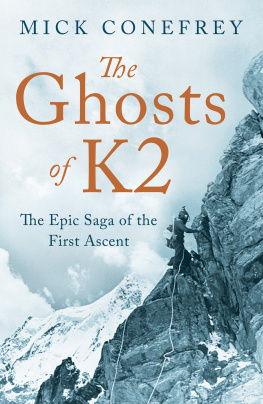HOW TO CLIMB MONT BLANC IN A SKIRT
It will entertain you as much as it will motivate you to live life on the edge.
Bust Magazine
Final proof, if any were needed, that you dont need a beard to explore the world.
Hugh Thomson, author of The White Rock: An Exploration of the Inca Heartland
A practical guide no self-respecting woman traveler should be without. After reading this book you will be reaching for the computer to book your next adventure. Quite irresistible.
Amanda Faber, Producer of The Race for Everest
ABOUT THE AUTHOR
Mick Conefrey is the bestselling author of The Adventurers Handbook and a filmmaker who has made award-winning documentaries for the BBC on Arctic exploration and Himalayan mountaineering. He lives in Oxford.
A HANDBOOK FOR THE LADY ADVENTURER
A Oneworld Book
First Published in Great Britain and the Commonwealth by Oneworld Publications 2011
This ebook edition published by Oneworld Publications, 2011
Copyright Mick Conefrey, 2011
The moral right of Mick Conefrey to be identified as the Author of this work has been asserted by him in accordance with the Copyright, Designs, and Patents Act 1988
All rights reserved
Copyright under Berne Convention
A CIP record for this title is available from the British Library
ISBN: 9781851688661
Typeset by Jayvee, Trivandrum, India
Cover design by designed by david
Oneworld Publications
185 Banbury Road
Oxford OX2 7AR
England
Learn more about Oneworld. Join our mailing list to find out about our latest titles and special offers at:
www.oneworld-publications.com
To
Stella
PREFACE
A few years ago, after making a series of documentaries about mountaineering and Arctic exploration, I wrote The Adventurers Handbook, in which I attempted to look at the history of exploration in a slightly unusual way. I wanted to discover the life lessons that could be drawn from the experiences of the great explorers and the archetypal patterns that most expeditions follow.
Most of the characters in that book were men. I have to come clean and admit that I was simply ignorant of the long history of female travellers and explorers. Some of themfor example, Amelia Earhart and Freya Starkare still well known today, but none of them share the status of Ernest Shackleton, Roald Amundsen, or Reinhold Messner.
This book is a small attempt to redress the balance. Within these five chapters youll find the stories of dozens of female explorers, sailors, pilots, and horsewomen. A few made careers out of exploration; others only made one great journey. Most were brave, some were reckless, and all were fascinating. So why are they not better known? Often they were just as heroic, and just as eccentric, as the men. There is no question that Osa Johnson, Jackie Cochran, and Wanda Rutkiewicz lived exciting lives, but when it comes to exploration, women have rarely been accorded the same respect as their male counterparts.
Until very recently, exploration was seen as an almost exclusively male realm; anyone who had the temerity to challenge that view was heading for trouble. Women found it harder to raise money, to get permissions to travel to remote areas, and to be taken seriously. In spite of this, hundreds of women did take to the air, the sea, and the dusty road to follow their dreams or simply go in search of adventure. But did they approach exploration differently from men? Were their concerns and obsessions the same? And do their stories have anything to say about the wider difference between the sexes?
This is a dangerous territory to get into. There is nothing harder than making generalizations about men and women, and no easier way to make a fool of yourself than by claiming to understand the difference between them. No sooner do you find a pattern than someone invariably comes along to contradict it.
Exploration, though, is all about risk, and to avoid this rather fascinating question would be to take the easy way out. So with a nod to Mary Hall, the Victorian world tourist, I have decided to follow her mottoTake every precaution and abandon all fearand plunge deep into the dark continent of gender relations. My aim is to try to discover if there is a distinctly female approach to travel, and if so, what lessons can be learned from it.
First, though, a few words of gratitude to the people who have helped and supported me with this book. I would like to thank Christina Dodwell, Dominique Jean, Hugh Thompson, Amanda Faber, Carmel Conefrey, David Presswell, the staff of the Bodleian Library, the staff and trustees of the London Library, Anthony Sheil, Sally Riley and Leah Middleton at Aitken Alexander Ltd., Bettina Feldweg at Piper, Alessandra Bastagli at Palgrave Macmillan, and Mike Harpley at Oneworld. I would like to give special thanks to Adam T. Burton, who so beautifully illustrated this book. As ever, I owe a huge debt to my children, Frank and Phyllis, who put up with my absences, and most of all to my darling wife, Stella, without whose kindness and consideration this book could never have been written.

Chapter One
WHO, WHY, AND HOW?
Few such moments of exhilaration can come as that which stands at the threshold of wild travel.
GERTRUDE BELL, TWENTIETH-CENTURY DESERT EXPLORER
If women can be railway workers, why cant they fly in space?
VALENTINA TERESHKOVA, COSMONAUT

WHO?
Ask someone to describe a typical explorer and they will usually have a pretty good idea. Explorers have lined faces, scraggy beards, skin that has been punished by the wind and sun. Sometimes they wear furs; sometimes they wear khaki. They either smile at the camera in triumph or they stare with gritty resolution.
And they are men.
Or are they?
Which explorer found the lost city of Cana in the Middle East?
Which mountaineer first mapped the Siachen Glacier in the Himalayas?
Who was first to the top of Huascarn in Peru?
Which European was first to visit the Ottoman harem in Constantinople?
Who held the world record for the fastest flight from Britain to Australia for 44 years?
Youll find the answers to all of these questions within these pages, and none of the protagonists will have a scraggy beard. This book is about female explorers and travellers. Who were they? What did they achieve? And what can we learn from them?
The lost history of female exploration includes women who travelled to every corner of the globe: mountaineers like Fanny Bullock Workman and Annie Smith Peck, sailors like Ann Davison and Naomi James, desert explorers such as Rosita Forbes and Freya Stark, polar explorers such as Ann Bancroft and Pam Flowers, and African queens such as May French Sheldon and Mary Kingsley. A handful of them are still well known today, some enjoyed just a few fleeting months in the headlines, and others never saw the limelight at all.
Next page
